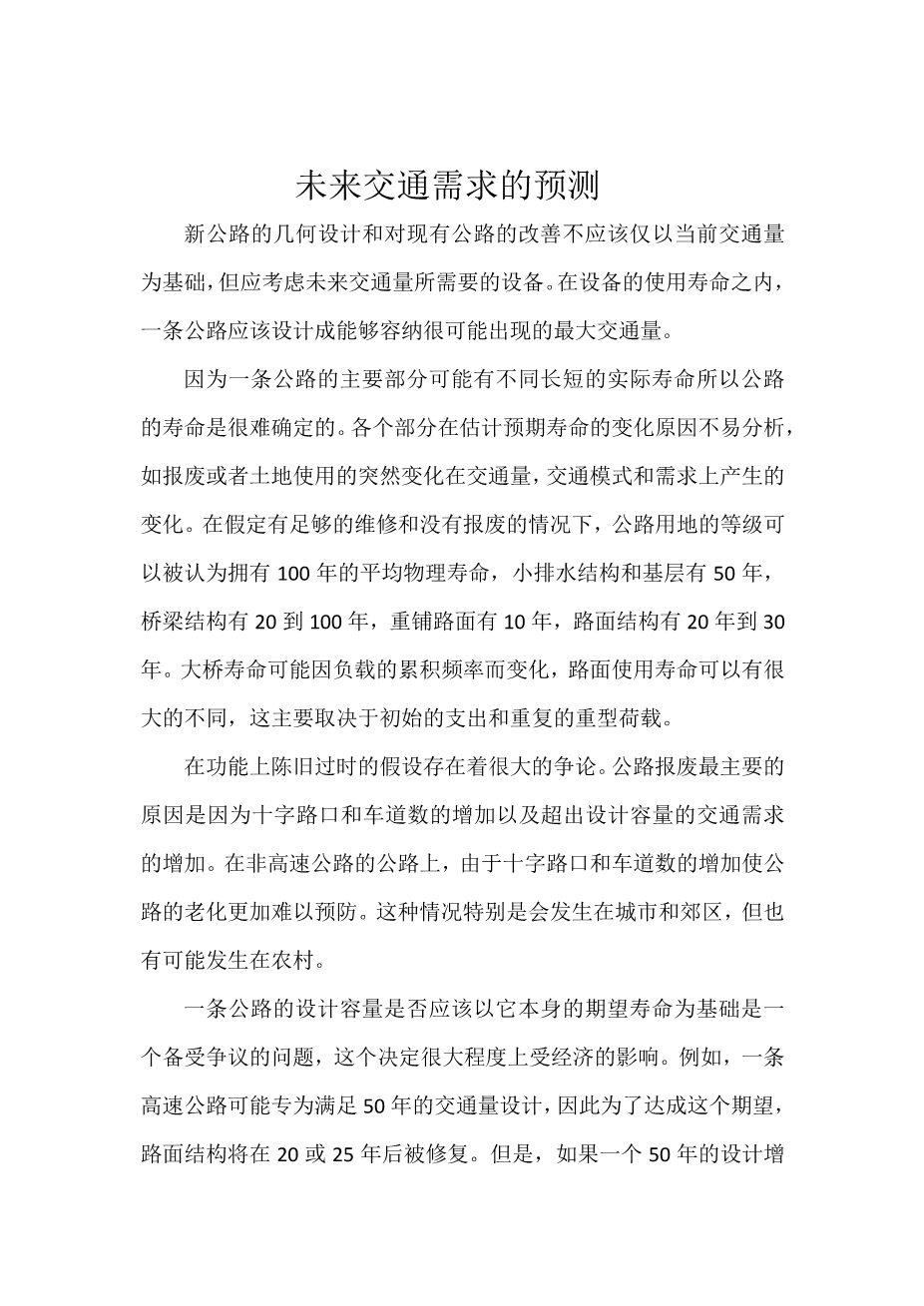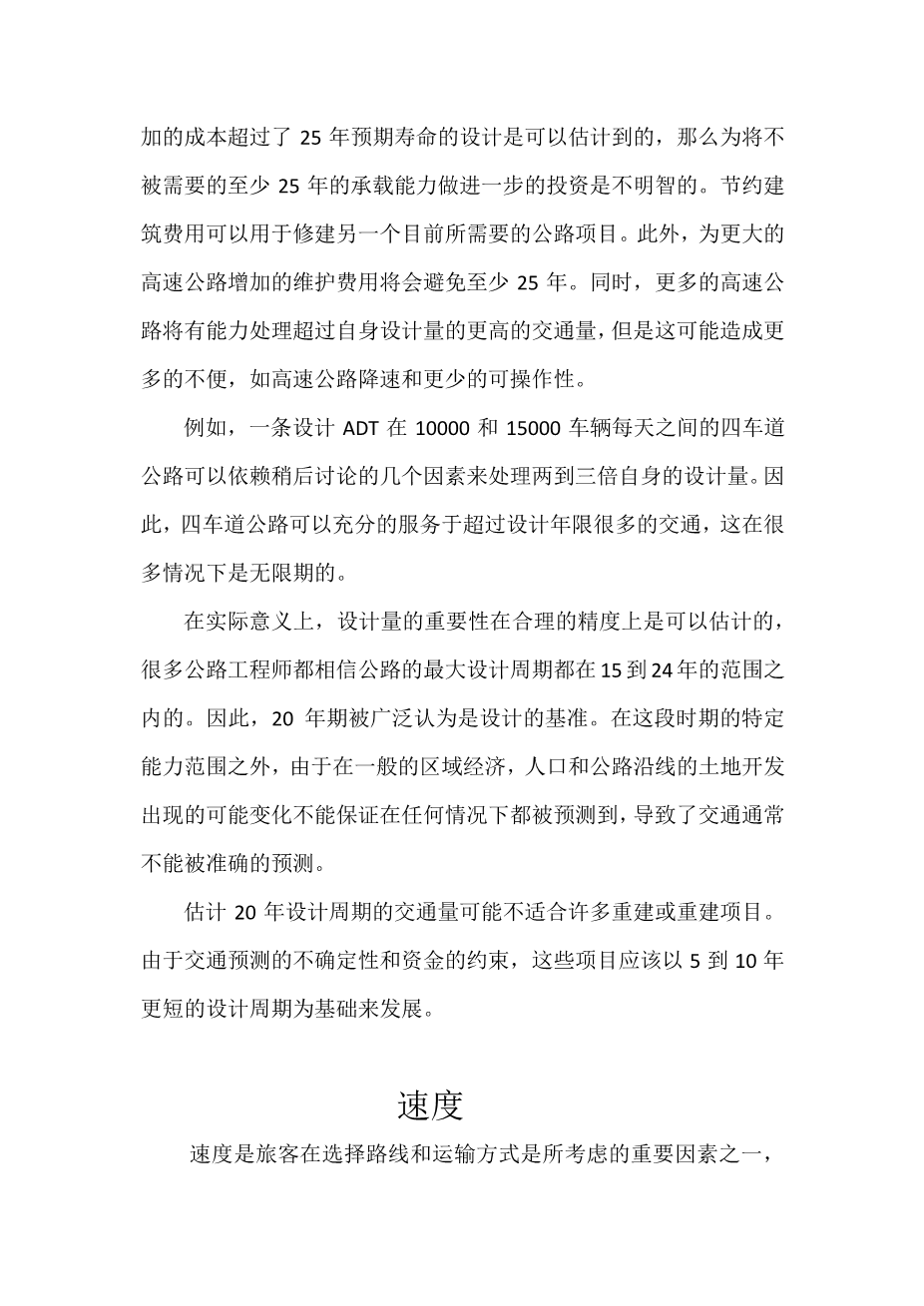新建公路设计(二)外文翻译资料
2022-10-25 11:59:58
Projection of Future Traffic Demands
Geometric design of new highways or improvements to existing highways should not usually be based on current traffic volumes alone, but should consider future traffic volumes expected to use the facility. A highway should be designed to accommodate the traffic volume that is likely to occur within the design life of the facility.
It is difficult to define the life of a highway because major segments may have different lengths of physical life. Each segment is subject to variations in estimated life expectancy for reasons not readily subject to analysis, such as obsolescence or unexpected radical changes in land use, with the resulting changes in traffic volumes, patterns, and demands. Right-of-way and grading may be considered to have a physical life expectancy of 100 years; minor drainage structures and base courses, 50 years; bridges, 25 to 100 years; resurfacing, 10 years; and pavement structure, 20 to 30 years, assuming adequate maintenance and no allowance for obsolescence. Bridge life may vary depending on the cumulative frequency of heavy loads. Pavement life can vary widely, depending largely on initial expenditures and the repetition of heavy axle loads.
The assumption of no allowance for functional obsolescence is open to serious debate. The principal causes of obsolescence are increases in the number of intersections and driveways, and increases in traffic demand beyond the design capacity. On non-freeway highways, obsolescence due to addition of intersections and driveways is much more difficult to forestall; this occurs particularly in urban and suburban areas, but may occur in rural areas as well.
It is a moot question whether the design capacity of a highway should be based on its life expectancy. The decision is greatly influenced by economics. For example, a highway might be designed for traffic volumes 50 years hence with the expectation that the pavement structure would be restored in 20 to 25 years. However, if the added cost of a 50-year design over a design with a 25-year life expectancy is appreciable, it may be imprudent to make a further investment providing capacity that will not be needed for at least 25 years. The construction cost savings could be used to construct another currently needed highway project. Furthermore, the cost of increased maintenance for the larger highway would be avoided for at least 25 years. Also, most highways are capable of handling higher traffic volumes than their design volume indicates, but this may cause more inconvenience, such as a reduction in speed and less maneuverability.
For example, a four-lane divided highway with a design ADT of 10,000 or 15,000 vehicles per day could handle two or three times that design volume depending on several factors discussed later. Thus, the four-lane divided highway could adequately serve traffic long after the design year and, in many cases, indefinitely.
In a practical sense, the design volume should be a value that can be estimated with reasonable accuracy. Many highway engineers believe the maximum design period is in the range of 15to 24 years. Therefore, a period of 20 years is widely used as a basis for design. Traffic cannot usually be forecast accurately beyond this period on a specific facility because of probable changes in the general regional economy, population, and land development along the highway, which cannot be predicted with any degree of assurance.
Estimating traffic volumes for a 20-year design period may not be appropriate for many reconstruction or rehabilitation projects. These projects may be developed on the basis of a shorter design period (5 to 10 years) because of the uncertainties of predicting traffic and funding constraints.
Speed
Speed is one of the most important factors considered by travelers in selecting alternative routes or transportation modes. Travelers assess the value of a transportation facility in moving people and goods by its convenience and economy, which are directly related to its speed. The attractiveness of a public transportation system or a new highway are each weighed by the travelers in terms of time, convenience, and money saved. Hence, the desirability of rapid transit may well rest with how rapid it actually is. The speed of vehicles on a road or highway depends, in addition to capabilities of the drivers and their vehicles, upon five general conditions: the physical characteristics of the highway, the amount of roadside interference, the weather, the presence of other vehicles, and the speed limitations (established either by law or by traffic control devices). Although any one of these factors may govern travel speed, the effect of these general conditions is usually interrelated.
The objective in design of any engineered facility used by the public is to satisfy the publicrsquo;s demand for service in a safe and economical manner. The facility should, therefore, accommodate nearly all demands with reasonable adequacy and also should not fail under severe or extreme traffic demands. Therefore, highways should be designed to operate at a speed that satisfies nearly all drivers. Because only a small percentage of drivers travel at extremely high speed, it is not economically practical to design for them. They can use the highway, of course, but will be constrained to travel at speeds less than they consider desirable. On the other hand, the speed chosen for design should not be that used by drivers under unfavorable conditions, such as inclement weather, because the highway would then be inefficient , and possibly unsafe ,for drivers under favorable conditions, and would not satisfy reasonable public expectations for the facility.
Operating Speed
Operating speed is the speed at which drivers are observed operating their vehicles during free-flow conditions. The 85th per
剩余内容已隐藏,支付完成后下载完整资料


英语原文共 10 页,剩余内容已隐藏,支付完成后下载完整资料
资料编号:[151903],资料为PDF文档或Word文档,PDF文档可免费转换为Word




